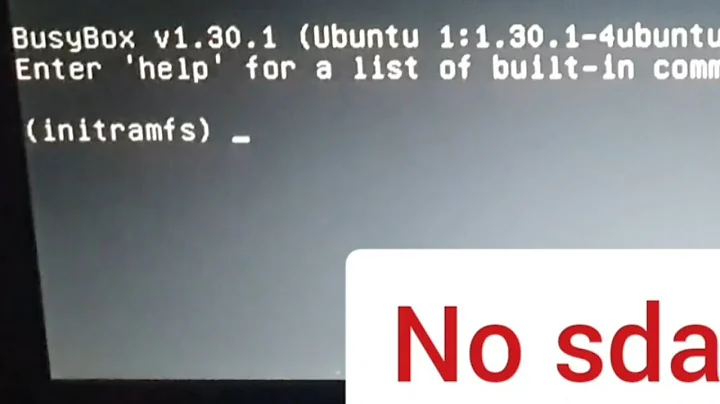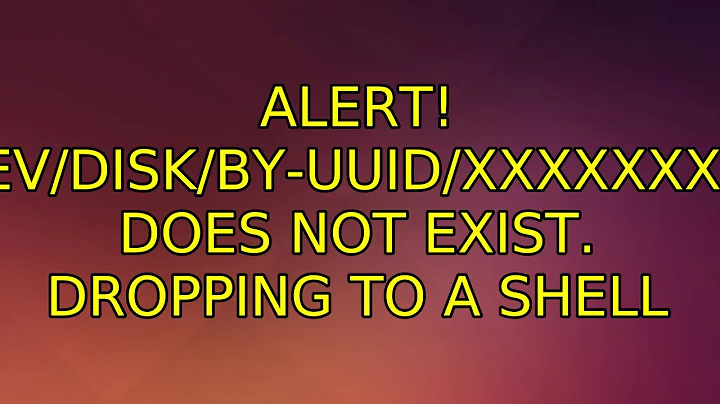UUID=xxx does not exist. Dropping to a shell
Solution 1
When I tried to use a pendrive Ubuntu to figure out this problem, I finally found out that the hard drive wasn't recognized when Legacy Boot was disabled. This explained why manually choosing UEFI did work.
The problem was that the new motherboard had the default settings, so RAID was enabled. Switching to AHCI solved my problem. This were the steps needed to change it: (borrowed from This answer)
- Boot into BIOS (F12 at startup)
- Select Bios Setup
- Move to System Configuration→SATA Operation and select AHCI
Solution 2
The answer is contained within your fstab file itself:
# / was on /dev/nvme0n1p3 during installation
UUID=dd84f4b3-d5bf-42e4-9b5e-ec685a461fad / ext4 errors=remount-ro 0 1
# /boot/efi was on /dev/nvme0n1p1 during installation
UUID=B38D-559B /boot/efi vfat umask=0077 0 1
# swap was on /dev/nvme0n1p4 during installation
UUID=f4134c38-10b9-478f-b550-54650a9f5140 none swap sw 0 0
so replace the UIDs with the oldfashioned names in your fstab:
# /etc/fstab: static file system information.
#
# Use 'blkid' to print the universally unique identifier for a
# device; this may be used with UUID= as a more robust way to name devices
# that works even if disks are added and removed. See fstab(5).
#
# <file system> <mount point> <type> <options> <dump> <pass>
/dev/nvme0n1p3 / ext4 errors=remount-ro 0 1
/dev/nvme0n1p1 /boot/efi vfat umask=0077 0 1
/dev/nvme0n1p4 none swap sw 0 0
and reboot.
If that doesn't solve your problem 100%, the true error lies deeper and you will have to compare your UEFI settings between the old and new MoBo.
Related videos on Youtube
Stephan Vierkant
Updated on September 18, 2022Comments
-
Stephan Vierkant over 1 year
Because of a hardware failure my motherboard has just been replaced. After the replacement, my system (Ubuntu 17.10) doesn't boot:
ALERT! UUID=dd84f4b3-d5bf-42e4-9b5e-ec685a461fad does not exist. Dropping to a shell.
I've used a Live USB Ubuntu to debug this problem. Here are some results:
/etc/fstab
# /etc/fstab: static file system information. # # Use 'blkid' to print the universally unique identifier for a # device; this may be used with UUID= as a more robust way to name devices # that works even if disks are added and removed. See fstab(5). # # <file system> <mount point> <type> <options> <dump> <pass> # / was on /dev/nvme0n1p3 during installation UUID=dd84f4b3-d5bf-42e4-9b5e-ec685a461fad / ext4 errors=remount-ro 0 1 # /boot/efi was on /dev/nvme0n1p1 during installation UUID=B38D-559B /boot/efi vfat umask=0077 0 1 # swap was on /dev/nvme0n1p4 during installation UUID=f4134c38-10b9-478f-b550-54650a9f5140 none swap sw 0 0blkid
/dev/nvme0n1p1: SEC_TYPE="msdos" UUID="B38D-559B" TYPE="vfat" PARTLABEL="EFI System Partition" PARTUUID="98be6c97-c354-49a6-a432-9201d56a421b" /dev/nvme0n1p2: LABEL="OS" UUID="B39E-7035" TYPE="vfat" PARTLABEL="fat32" PARTUUID="d3006358-8d82-4e0b-99f8-87a5261cf7e8" /dev/nvme0n1p3: LABEL="UBUNTU" UUID="dd84f4b3-d5bf-42e4-9b5e-ec685a461fad" TYPE="ext4" PARTUUID="24e5b96d-f20c-43dd-9e48-672760b0e6f7" /dev/sda1: LABEL="UBUNTU 17_1" UUID="88D4-322D" TYPE="vfat" PARTUUID="3d0a270b-01"fdisk -l
Disk /dev/loop0: 1.3 GiB, 1427259392 bytes, 2787616 sectors Units: sectors of 1 * 512 = 512 bytes Sector size (logical/physical): 512 bytes / 512 bytes I/O size (minimum/optimal): 512 bytes / 512 bytes Disk /dev/nvme0n1: 477 GiB, 512110190592 bytes, 1000215216 sectors Units: sectors of 1 * 512 = 512 bytes Sector size (logical/physical): 512 bytes / 512 bytes I/O size (minimum/optimal): 512 bytes / 512 bytes Disklabel type: gpt Disk identifier: 43E35EBE-2A73-404A-9D4A-851815F33F9A Device Start End Sectors Size Type /dev/nvme0n1p1 34 488281 488248 238.4M EFI System /dev/nvme0n1p2 488282 5934980 5446699 2.6G Microsoft basic data /dev/nvme0n1p3 5935104 933576703 927641600 442.3G Linux filesystem /dev/nvme0n1p4 933576704 1000214527 66637824 31.8G Linux swap Disk /dev/sda: 28.7 GiB, 30752636928 bytes, 60063744 sectors Units: sectors of 1 * 512 = 512 bytes Sector size (logical/physical): 512 bytes / 512 bytes I/O size (minimum/optimal): 512 bytes / 512 bytes Disklabel type: dos Disk identifier: 0x3d0a270b Device Boot Start End Sectors Size Id Type /dev/sda1 * 2048 60063743 60061696 28.7G c W95 FAT32 (LBA)It looks like the UUID's in
fstabare correct, but I still get that error message.How can I repair my Ubuntu installation?
I've tried the given solution in ALERT! /dev/disk/by-uuid/xxxxxxxxx does not exist. Dropping to a shell, but unfortunately that didn't help (I mounted
/dev/nvme0n1p3). Still the same problem.Update: When I select UEFI boot mode in system setup, I still get this problem. But when I select legacy boot I got 'no boot device found'. But here comes the tricky part: when I select legacy mode and use F12 to select UEFI/Ubuntu, it starts without a problem.
-
 Yaron over 6 yearsPossible duplicate of ALERT! /dev/disk/by-uuid/xxxxxxxxx does not exist. Dropping to a shell
Yaron over 6 yearsPossible duplicate of ALERT! /dev/disk/by-uuid/xxxxxxxxx does not exist. Dropping to a shell -
Stephan Vierkant over 6 yearsSorry, forget to add that I did try that solution. It's added to the question now.
-
Stephan Vierkant over 6 yearsProblem found: I had to switch to legacy boot to get access to both the pendrive and hard disk, but had to switch back to UEFI to get the hard disk bootable as it was.
-
 Yaron over 6 yearsYou might want to use the info in your comment (detailed version) as an answer to your question
Yaron over 6 yearsYou might want to use the info in your comment (detailed version) as an answer to your question -
 David Foerster over 6 yearsIf you solved your problem yourself, please answer your own question and accept your answer. Don’t put the answer in your question or the comments! Send me a message in the comments if you want my up-vote. :-)
David Foerster over 6 yearsIf you solved your problem yourself, please answer your own question and accept your answer. Don’t put the answer in your question or the comments! Send me a message in the comments if you want my up-vote. :-) -
Stephan Vierkant over 6 years@Yaron Unfortunately, I haven't got a solution yet. When I select UEFI boot mode in system setup, I still get this problem. But when I select legacy boot I got 'no boot device found'. But here comes the tricky part: when I select legacy mode and use F12 to select UEFI/Ubuntu, it starts without a problem.
-
stackOverlord almost 6 yearsI have the exact same problem. fstab is correct. The UUID it's looking for is correct. Also using UEFI. Unfortunately for me my bios doesn't give me the option to "legacy boot". Hope someone helps.
-
Stephan Vierkant almost 6 years@DavidFoerster I will answer my question when I've got the full solution, but for now my problem isn't fixed yet :(.
-
xiota almost 6 yearsIs your new motherboard the same model and your old one? I suspect a motherboard-specific UEFI quirk. Also, you've probably done this already, but have you run
fsck -fon all your partitions?
-
-
Stephan Vierkant almost 6 yearsMy disk lay-out hasn't changed after the motherboard replacement, so that can't be the problem in my case.
-
Stephan Vierkant almost 6 yearsThat doesn't make any difference :(.
-
 Fabby almost 6 yearsBoth UEFI and BIOS mode? (Sorry, if it doesn't help, I'll delete my answer). How did you get the BLKIDs? In another machine or by booting a USB/DVD ? /dev/sda is a 32GB USB stick?
Fabby almost 6 yearsBoth UEFI and BIOS mode? (Sorry, if it doesn't help, I'll delete my answer). How did you get the BLKIDs? In another machine or by booting a USB/DVD ? /dev/sda is a 32GB USB stick? -
Stephan Vierkant almost 6 yearsWith UEFI it goes to Busybox, with BIOS 'no boot device', but with BIOS enabled and manually selecting UEFI it boots normally. Very strange.
-
 Fabby almost 6 yearsOK, so it does work... Hmmmm, Can you drop by in chat and ping me there??
Fabby almost 6 yearsOK, so it does work... Hmmmm, Can you drop by in chat and ping me there?? -
Stephan Vierkant almost 6 yearsWhen I disable Legacy Boot/BIOS, my SSD doesn't show up when using a Ubuntu Live CD. Maybe that's relevant?
-
Stephan Vierkant almost 6 yearsBut when I enable legacy boot, press F12 and select Ubuntu from USB from the UEFI boot list, it shows up. I don't understand why there is a difference between between selecting UEFI and disabling legacy boot. (and I struggle to describe this properly, I hope you understand?)
-
 Fabby almost 6 yearsI understand completely: that's the way the previous system was probably installed
Fabby almost 6 yearsI understand completely: that's the way the previous system was probably installed -
 Fabby almost 6 yearsAn edit and an upvote. You should have your 50 rep nearly back by now... ;-)
Fabby almost 6 yearsAn edit and an upvote. You should have your 50 rep nearly back by now... ;-) -
 WinEunuuchs2Unix almost 6 yearsAnd you should probably award the bounty to @Fabby too :)
WinEunuuchs2Unix almost 6 yearsAnd you should probably award the bounty to @Fabby too :) -
 Fabby almost 6 years@WinEunuuchs2Unix No! He should do nothing and not award anything, then the bountry will be automatically split.
Fabby almost 6 years@WinEunuuchs2Unix No! He should do nothing and not award anything, then the bountry will be automatically split. -
 WinEunuuchs2Unix almost 6 years@Fabby The OP can't get half his own bounty right? So half will be lost and you will get the other half right?
WinEunuuchs2Unix almost 6 years@Fabby The OP can't get half his own bounty right? So half will be lost and you will get the other half right? -
 Fabby almost 6 yearsyup. @WinEunuuchs2Unix
Fabby almost 6 yearsyup. @WinEunuuchs2Unix -
 Admin almost 4 yearsThank you. This solved my issue!
Admin almost 4 yearsThank you. This solved my issue! -
 no more segmentation faults almost 3 yearsCan't thank you enough.
no more segmentation faults almost 3 yearsCan't thank you enough. -
fchen over 2 yearsThis works for me for a different issue: Ubuntu installed on Legacy BIOS mode then when installing Windows 10 it complains "Windows cannot be installed to this disk. The selected disk is of the GPT partition style”. Changed to UEFI only and installed windows, then Ubuntu cannot boot. Followed RAID->AHCI and ubuntu works however the windows cannot find a bootable disk. Boot with Windows installation disk and tried to repair the installation -- not working. I ended up with a new installation of Windows since it's easier in my case.
-
 Admin almost 2 yearsWhen I gave my laptop for repair I had the same problem. This saved me. I had no clue. BIOS settings were changed during the repair
Admin almost 2 yearsWhen I gave my laptop for repair I had the same problem. This saved me. I had no clue. BIOS settings were changed during the repair




